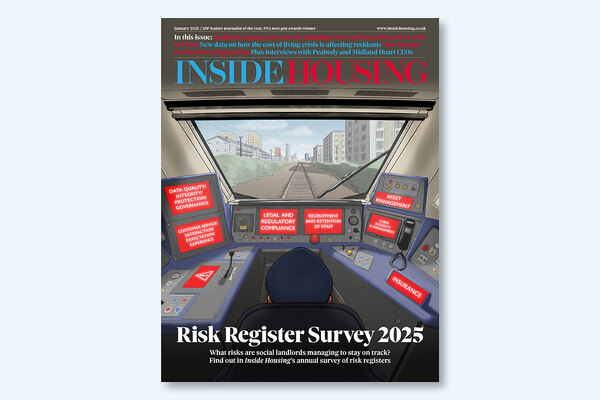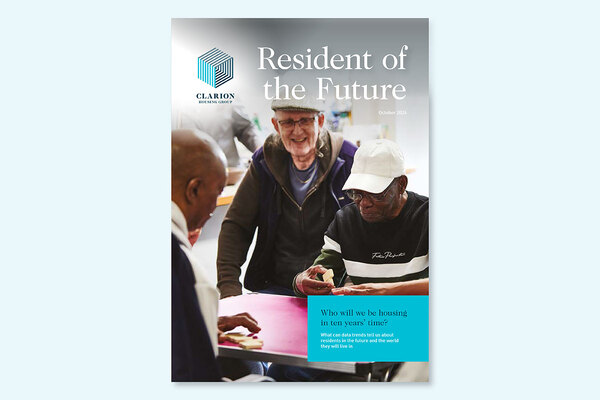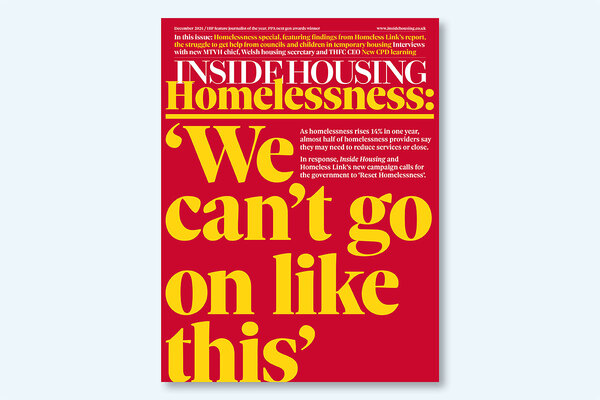You are viewing 1 of your 1 free articles
The holes that must be fixed in our benefits safety net
As the pandemic pushes more people than ever to the benefits system, many are finding that it does not provide enough to cover their housing costs. Peter Apps asks what is going wrong. Illustration by Shonagh Rae
“No one should lose their home as a result of the coronavirus epidemic.”
This was the pledge from housing secretary Robert Jenrick in March last year, as the country took its first steps down the long road of its pandemic response.
He halted possession proceedings, a policy that is set to end in England on 8 March, a move echoed by devolved governments across the UK. But at best this only stops people losing their homes during the pandemic. To stop them losing their homes “as a result” of it, they need to be provided with a means to pay the rent if they lose their income. This should be a job for the welfare system – but it is not one it is doing.
“A lot of the new claimants are likely to be people who entered into rental contracts never expecting to be reliant on benefits, but then lost their job”
The National Residential Landlords Association estimates that 800,000 private renters have built up arrears since the pandemic began. An update from the Regulator of Social Housing showed rent arrears in social housing at 3.98% of all rent collected in England, rising to 5.5% in London – the worst figures in recent years.
Perhaps this should not surprise us. According to the Joseph Rowntree Foundation, an estimated 42% of social renters and 35% of private renters work in the four sectors hardest hit by the pandemic.
But the safety net does not appear to be catching them. So, are there holes in it? And if so, where are they?
Universal Credit: the five-week wait
The problems with Universal Credit were well publicised before coronarvirus hit. While chancellor Rishi Sunak spent £6bn to increase the amount of cash available through the benefit by an additional £20 a week and suspended the minimum income floor, making many more self-employed people eligible to claim the payments, he did nothing to end one of the most controversial elements of the benefit: the five-week wait.
Once a benefit claim is accepted, the claimant waits five weeks before receiving the first payment. The idea is to mimic the world of work where the first pay cheque is not on the first day of employment, but this leaves people struggling to make ends meet.
Between 12 March and 8 October last year, take-up of Universal Credit soared: there was a 90% increase – with claimants rising from below three million to 5.8 million by November. A large number of these were single people with no dependants (2.6 million by August 2020, up from 1.26 million in January) and an increasing number were out of work (2.27 million by November, compared to 1.02 million in January).
Advance payments can be claimed to pay bills in this time, but they are recouped from future payments. Experimental data from the Department for Work and Pensions (DWP) shows that between the introduction of the first lockdown and 23 June, 1.02 million advances were paid to new claimants across the UK. All of these people would have had future payments reduced to repay this debt.
A survey of 386 claimants carried out by the Trades Union Congress in the summer reported that 86% found that an advance put pressure on their household budgets. Many have turned to foodbanks since, and one in five struggled to keep up with bills, including rent.
The Trussell Trust estimates that during the crisis, 73% of foodbank users on Universal Credit were paying back an advance. This was up from 51% in normal times.
Local Housing Allowance
The problems do not end when the payments start. The amount of Universal Credit offered to cover housing costs is dictated by Local Housing Allowance (LHA) – a formula that covers the lowest 30% of local rents (it was 50% before 2011). This was frozen for four years from 2016 – so while rents rose, benefit entitlements did not. In March, Mr Sunak effectively reversed this cut: LHA rates were returned to the calculation of the 30th percentile for 2020.
“The rate for central London has been stumbling along at about £150 a week. That really isn’t enough when trying to move younger people into a settled home”
But the freeze was never the only issue with LHA. People under 35, for example, are only entitled to claim what is known as the ‘shared room rate’. This is the estimate rate for a shared room in a house, rather than a self-contained property. This is a low threshold – as the graph above shows, anyone in a one-bedroom flat is going to face a severe shortfall. In Westminster, median rents suggest this could be as much as £1,300 a month. But even in Newcastle a claimant would be around £250 short of the rent. Many of those who lost jobs during the pandemic may have much higher housing costs.
“A lot of the new claimants are likely to be people who entered into rental contracts never expecting to be reliant on benefits, but then lost their job. They may have a self-contained flat but can only claim the rate for a room. That can be quite a large difference in rent,” explains Sam Lister, a policy and professional practice officer at the Chartered Institute of Housing.
Even for those in rooms, there are shortfalls against median rents (a consequence of the threshold being capped at the 30th percentile). In Westminster this will be £220, in Newcastle £79.
Marc Francis, policy and campaigns director at charity Z2K Trust, also queries whether the rates offered for shared rooms correctly reflect the market. “The rate for central London has been stumbling along at about £150 a week,” he says. “That really isn’t enough when trying to move younger people into a settled home.”
Anyone else renting a home above the 30th percentile of local rents will also be experiencing a shortfall. As will those who are deemed to be ‘under-occupying’ under bedroom tax rules, a cut that still limits the entitlement of at least a quarter of a million housing benefit claimants. Both could quickly result in substantial arrears, and this is before we even consider the overall benefit cap.
The benefit cap
The benefit cap places a limit on the amount of total welfare any household can receive in a single year. Since 2015, this cap has been £23,000 in Greater London and £20,000 in the rest of England (falling to £15,410 and £13,400 respectively for families with no children).
The explosion of claims for Universal Credit coincided with an explosion in those having their benefits capped. In February 2020, 46,850 households claiming Universal Credit had the benefit cap imposed. By August, this figure was 142,350. By November, 170,000 households were hit by the cap. Analysis in London shows this to be particularly severe. It rose from 12,604 in February to 46,488 by August – an increase of 269%.
“It’s housing costs that normally push you over the cap limit,” explains Mr Lister. “That’s probably the reason we’ve had such a huge spike, because all the LHA rates were recalibrated, that becomes a bigger chunk of award and you are more likely to be capped.”
This has been a particular concern to London boroughs. One senior source says: “The increases to benefits have pushed people up towards the cap. And the people claiming benefits now are not the traditional make-up – people who lost jobs as a result of the pandemic and have rents that are much higher than a traditional benefit claimant might have.”
What is particularly worrying about this is that the benefit cap comes with a nine-month ‘grace period’ for people who had a steady income to a certain threshold before losing their job. For those who came into the Universal Credit system from March onwards, this is only now set to expire – exacerbating personal financial crises at the time of greatest stress from the pandemic.
Research by the Child Poverty Action Group estimates that between December 2020 and March 2021, a further 76,000 households will be capped – 63,000 by the end of January. Three-quarters of them are families with children and they faced losing an average of £62 a week.
Under the rules of Universal Credit, councils do not know the identities of those set to be capped at the end of the grace period – this data is held centrally and not shared. “There could be tens of thousands of people in London who are about to be capped, but boroughs don’t know who they are,” says one source.
Case study: ‘People are losing the security of a roof over their head’
Jessica (name changed) is one such client. She was working before the pandemic and when she applied to Universal Credit she found that she was affected by the benefit cap – so like many people she cannot access the increase to Local Housing Allowance that the government introduced in to help people pay their rent.
She has had to apply for several DHPs to top up her rent while she looks for a job – but as everyone knows there are a lot more people unemployed than there are jobs at the moment, and has had no luck.
When she applies, the council responds with letters that talk about its “limited budget” and says that DHPs are a “one-off” and that “it is highly unlikely you will be assisted further”.
Z2K has had to fight to get Jessica the support she needs, and the precarity of her situation is leaving her anxious and depressed.
She says: “People are losing the security of a roof over their head.”
Discretionary Housing Payments
When challenged over these shortfalls in the benefit system, the government often points to Discretionary Housing Payment (DHP) funding as the answer.
This is £180m of funding distributed among local authorities, which they can use to assist the most urgent cases to prevent people losing their homes. Government data published in December shows that at the midpoint of the financial year, councils had spent 40% of their allocation, down from 49% at the same point last year.
Spending was highest in London, where councils had spent 46% of their allocation, and lowest in the East Midlands, which had spent 32%.
“Councils are much more inclined to use money to support families in temporary accommodation, essentially using it to stop arrears arising on their own rent account”
But this data does not reveal how many applications have been received and refused or approved. So Inside Housing gathered some under a Freedom of Information Act request. The 200 councils that responded had received 112,966 applications, rejecting 33,547 (28.9%) – a similar proportion to the same period last year. But approaches differed greatly between councils.
At one end of the scale, Waltham Forest Council in east London rejected 76.9% of all applications (753 of 979), while Gedling Council rejected only 1.2% (three of 254 applications). While 21 authorities rejected more than half of all applications, at the other end of the scale 21 approved more than 90%.
Gedling said the figures showed its scheme was “targeting the right people”, while a spokesperson for Waltham Forest Council said it was strict in its criteria to prioritise those in the greatest need,
Sophie Earnshaw, a solicitor at Shelter, says this does not surprise her. “The name says it all: it’s discretionary,” she explains. “Local authorities have the power to assess who is eligible and there is no right of appeal beyond judicial review.”
Demand is also limited by the lack of knowledge about DHP. “Most claimants would not even know this pot of money is available. It’s often not easy to find information about DHPs on websites and it’s only when they seek advice that they become aware of it,” Ms Earnshaw adds.
Mr Francis says: “One of the things we found is that councils are much more inclined to use money to support families in temporary accommodation, essentially using it to stop arrears arising on their own rent account.”
There are wider problems with DHP. It was designed as a form of short-term payment to cover gaps in the benefit system while people find work or a new home. As such, payments are often limited to three or six-month periods. But this is less relevant to the current crisis.
“I’ve got clients who were working before the pandemic, lost their job, found Universal Credit doesn’t cover their rent, applied for DHP and got a top-up, but then the DHP runs out and they are back into the position where they can’t pay their rent,” says Rose Bernstein, tenant voice and campaigns officer at Z2K Trust.
Ms Earnshaw adds there can be a long wait for a decision on DHP. “That is a particular problem when possession proceedings are in place,” she says.
Ultimately the problem is that DHP simply cannot fill the gaps in the rest of the safety net. “DHP should be the icing and not the cake,” says Mr Lister. “There are too many gaps in the safety net generally and that’s driving the underlying demand. It was never designed to cope with that kind of scale.”
Top five local authorities for DHP refusals
Local authority | Applications | Refused | % refused |
Waltham Forest | 979 | 753 | 76.9 |
Canterbury | 349 | 253 | 72.5 |
Slough | 159 | 115 | 72.3 |
Erewash | 516 | 336 | 65.1 |
Test Valley | 113 | 65 | 57.5 |
Top five local authorities for DHP approvals
Local authority | Applications | Refused | % refused |
Gedling | 254 | 3 | 1.2 |
Melton | 83 | 1 | 1.2 |
West Berks | 229 | 3 | 1.3 |
Solihull | 197 | 3 | 1.5 |
Fareham | 84 | 2 | 2.4 |
The future
The future is not particularly bright. Despite widespread calls for LHA rates to be lifted to the 50th percentile, they are set to be refrozen at the 2020 level. The £20 boost to Universal Credit introduced in April is also set to be removed when the financial year ends in March.
There have been repeated warnings of a flood of evictions once the ban is lifted, although this may not be how it transpires in practice.
“What comes through from previous research into benefit reductions is that people try to manage and paper over the cracks, and only when all of their options have run out do things collapse,” says Mr Lister.
“It doesn’t tend to appear as a catastrophic blip, and I think the government knows that. But it doesn’t mean people aren’t under enormous stress.”
Senior figures in councils and housing charities, though, do tell Inside Housing that they are “bracing for an avalanche of possession claims” once the eviction ban is lifted. And with the amount of people in arrears, there is no reason to believe they will not.
A DWP spokesperson said: “We’ve taken unprecedented action to protect renters during this pandemic, including banning evictions, as well as increasing LHA rates, benefiting more than one million households by £600 a year on average. We’ve also raised Universal Credit by £1,040 a year, and DHPs are available for those who need additional support.”
But impressive as these steps sound in isolation, the issue is that a decade of cuts has reduced the function of welfare as a safety net at the time when it is most needed. Sadly, unless things change rapidly, Mr Jenrick’s promise is likely to ring hollow.
Sign up for our tenancy management newsletter
Already have an account? Click here to manage your newsletters














